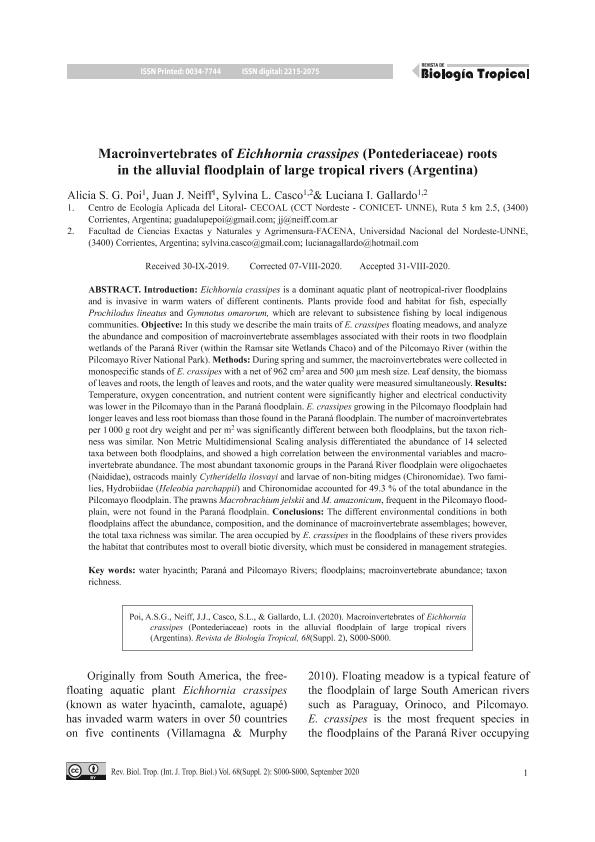Mostrar el registro sencillo del ítem
dc.contributor.author
Poi, Alicia Susana G.

dc.contributor.author
Neiff, Juan Jose

dc.contributor.author
Casco, Sylvina Lorena

dc.contributor.author
Gallardo, Luciana Irene

dc.date.available
2022-07-28T12:46:55Z
dc.date.issued
2020-10
dc.identifier.citation
Poi, Alicia Susana G.; Neiff, Juan Jose; Casco, Sylvina Lorena; Gallardo, Luciana Irene; Macroinvertebrates of Eichhornia crassipes (Pontederiaceae) roots in the alluvial floodplain of large tropical rivers (Argentina); Revista de Biología Tropical; Revista de Biología Tropical; 68; 10-2020; 1-12
dc.identifier.issn
0034-7744
dc.identifier.uri
http://hdl.handle.net/11336/163374
dc.description.abstract
Introduction: Eichhornia crassipes is a dominant aquatic plant of neotropical-river floodplains and is invasive in warm waters of different continents. Plants provide food and habitat for fish, especially Prochilodus lineatus and Gymnotus omarorum, which are relevant to subsistence fishing by local indigenous communities. Objective: In this study we describe the main traits of E. crassipes floating meadows, and analyze the abundance and composition of macroinvertebrate assemblages associated with their roots in two floodplain wetlands of the Paraná River (within the Ramsar site Wetlands Chaco) and of the Pilcomayo River (within the Pilcomayo River National Park). Methods: During spring and summer, the macroinvertebrates were collected in monospecific stands of E. crassipes with a net of 962 cm2 area and 500 μm mesh size. Leaf density, the biomass of leaves and roots, the length of leaves and roots, and the water quality were measured simultaneously. Results: Temperature, oxygen concentration, and nutrient content were significantly higher and electrical conductivity was lower in the Pilcomayo than in the Paraná floodplain. E. crassipes growing in the Pilcomayo floodplain had longer leaves and less root biomass than those found in the Paraná floodplain. The number of macroinvertebrates per 1 000 g root dry weight and per m2 was significantly different between both floodplains, but the taxon rich- ness was similar. Non Metric Multidimensional Scaling analysis differentiated the abundance of 14 selected taxa between both floodplains, and showed a high correlation between the environmental variables and macro- invertebrate abundance. The most abundant taxonomic groups in the Paraná River floodplain were oligochaetes (Naididae), ostracods mainly Cytheridella ilosvayi and larvae of non-biting midges (Chironomidae). Two fami- lies, Hydrobiidae (Heleobia parchappii) and Chironomidae accounted for 49.3 % of the total abundance in the Pilcomayo floodplain. The prawns Macrobrachium jelskii and M. amazonicum, frequent in the Pilcomayo flood- plain, were not found in the Paraná floodplain. Conclusions: The different environmental conditions in both floodplains affect the abundance, composition, and the dominance of macroinvertebrate assemblages; however, the total taxa richness was similar. The area occupied by E. crassipes in the floodplains of these rivers provides the habitat that contributes most to overall biotic diversity, which must be considered in management strategies.
dc.format
application/pdf
dc.language.iso
eng
dc.publisher
Revista de Biología Tropical

dc.rights
info:eu-repo/semantics/openAccess
dc.rights.uri
https://creativecommons.org/licenses/by-nc-sa/2.5/ar/
dc.subject
WATER HYACINTH
dc.subject
PARANA AND PILCOMAYO RIVERS
dc.subject
FLOODPLAINS
dc.subject
MACROINVERTEBRATE ABUNDANCE
dc.subject.classification
Ecología

dc.subject.classification
Ciencias Biológicas

dc.subject.classification
CIENCIAS NATURALES Y EXACTAS

dc.subject.classification
Otras Ciencias de la Tierra y relacionadas con el Medio Ambiente

dc.subject.classification
Ciencias de la Tierra y relacionadas con el Medio Ambiente

dc.subject.classification
CIENCIAS NATURALES Y EXACTAS

dc.title
Macroinvertebrates of Eichhornia crassipes (Pontederiaceae) roots in the alluvial floodplain of large tropical rivers (Argentina)
dc.type
info:eu-repo/semantics/article
dc.type
info:ar-repo/semantics/artículo
dc.type
info:eu-repo/semantics/publishedVersion
dc.date.updated
2021-09-17T16:44:28Z
dc.journal.volume
68
dc.journal.pagination
1-12
dc.journal.pais
Costa Rica

dc.journal.ciudad
Turrialba
dc.description.fil
Fil: Poi, Alicia Susana G.. Consejo Nacional de Investigaciones Científicas y Técnicas. Centro Científico Tecnológico Conicet - Nordeste. Centro de Ecología Aplicada del Litoral. Universidad Nacional del Nordeste. Centro de Ecología Aplicada del Litoral; Argentina
dc.description.fil
Fil: Neiff, Juan Jose. Consejo Nacional de Investigaciones Científicas y Técnicas. Centro Científico Tecnológico Conicet - Nordeste. Centro de Ecología Aplicada del Litoral. Universidad Nacional del Nordeste. Centro de Ecología Aplicada del Litoral; Argentina
dc.description.fil
Fil: Casco, Sylvina Lorena. Consejo Nacional de Investigaciones Científicas y Técnicas. Centro Científico Tecnológico Conicet - Nordeste. Centro de Ecología Aplicada del Litoral. Universidad Nacional del Nordeste. Centro de Ecología Aplicada del Litoral; Argentina
dc.description.fil
Fil: Gallardo, Luciana Irene. Consejo Nacional de Investigaciones Científicas y Técnicas. Centro Científico Tecnológico Conicet - Nordeste. Centro de Ecología Aplicada del Litoral. Universidad Nacional del Nordeste. Centro de Ecología Aplicada del Litoral; Argentina
dc.journal.title
Revista de Biología Tropical

dc.relation.alternativeid
info:eu-repo/semantics/altIdentifier/url/https://revistas.ucr.ac.cr/index.php/rbt/article/view/44342
Archivos asociados
